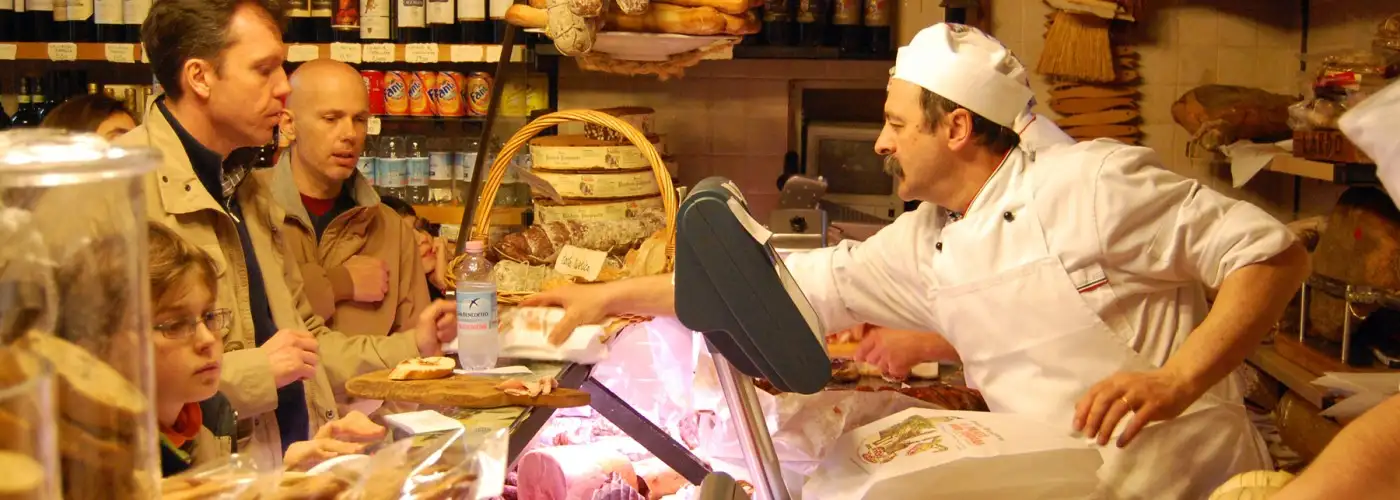Stretched across a Tuscan hill, Siena offers Italy’s best medieval city experience. With red-brick lanes tumbling every which way, the town is an architectural time warp, where pedestrians rule and the present feels like the past.
Most people are content to see Siena on a day trip (it’s just 35 miles south of Florence), but it’s worth a longer visit. Florence may have the big-time museums, but Siena was made for strolling. Staying at a little family-run inn in the old town center, I feel like an honorary Sienese.
Five hundred years ago, Italy was the center of humanism. Today, the self-assured Sienese remember their centuries-old accomplishments with pride. In the 1300s, Siena was one of Europe’s largest cities and a major military force, in a class with Florence, Venice, and Genoa. But weakened by a disastrous plague and conquered by her Florentine rivals, Siena became a backwater for six centuries.
Siena’s loss became our sightseeing gain, because its political and economic irrelevance preserved its Gothic-era identity, most notably its great, gorgeous central piazza—the Campo. People hang out as if at the beach at this tilted shell-shaped “square” of red brick. It gets my vote for the finest piazza in all of Europe.
Most Italian cities have a church on their main square, but the Campo gathers around Siena’s city hall, symbol of rational government, and a 330-foot municipal tower (open for climbers). If it’s true that a society builds its tallest towers to its greatest gods, then Siena worships secular effectiveness more than it trusts in God.
Nowadays, the city hall tends a museum collection of beautiful paintings (including a knockout work by hometown master Simone Martini). The 14th-century town council met here in the Sala della Pace (“Room of Peace”) under instructive frescoes reminding them of the effects of bad and good government: One fresco shows a city in ruins, overrun by greed and tyranny; the other fresco depicts a utopian republic, blissfully at peace.
If the Campo is the heart of Siena, the Duomo (or cathedral) is its soul. Sitting atop Siena’s highest point and visible for miles around, the white-and-dark-green-striped church is as over-the-top as Gothic gets. Inside and out, it’s lavished with statues and mosaics. The heads of 172 popes peer down on all those who enter.
Great art, including Michelangelo statues and Bernini sculptures, fills the church interior. Nicola Pisano carved the wonderful marble pulpit in 1268. It’s crowded with delicate Gothic storytelling—get up close to study the scenes from the life of Christ and the Last Judgment.
Hiding between the Duomo and the Campo are intriguing back streets, lined with colorful flags and studded with iron rings for tethering horses. Those flags represent the city’s neighborhood associations (or contrade), whose fierce loyalties are on vivid display twice each summer during the Palio, a wild bareback horse race around the Campo (held July 2 and August 16 every year; don’t show up without a hotel reservation if you hope to stay overnight).
Because Siena’s steep lanes go in anything but a straight line, it’s easy to get lost—but there’s no rush to get found. As you wander, you’ll be tempted by Sienese specialties in the shops along the way: gourmet pasta, vintage Chianti, boar prosciutto, extra-virgin olive oil, and panforte.
If you don’t think of panforte as fruitcake, you might like it. Some bakeries claim their recipes for this chewy concoction of nuts, honey, and candied fruits date back to the 13th century. Some even force employees to sign nondisclosure agreements to ensure they won’t reveal the special spice blend that flavors the dense cake.
It’s especially wonderful to be out and about in Siena in the evening, after the tour groups have left for the day. I like to take advantage of a fun trend in town, the aperitivo hour. Bars tucked here and there attract an early crowd by serving a free buffet of food with the purchase of a drink. It’s a light dinner obtained for the cost of a beverage.
After a quick aperitivo graze, I feel primed and ready to join the passeggiata—the evening stroll. I try to time my arrival at the Campo just at that magical moment when the sky is the same twilight hue as the rustic stones of the square.
As the Campo fills with people-watchers, I linger near the Renaissance water feature called the Fountain of Joy. Siena’s residents used to gather here to exchange gossip while filling their water jugs; it’s still a meeting point for tourists and locals. In six hundred years, not much has changed. Life in Siena is good.
Rick Steves (www.ricksteves.com) writes European travel guidebooks and hosts travel shows on public television and public radio. Email him at rick@ricksteves.com and follow his blog on Facebook.
(Photo: Rick Steves)
You Might Also Like:
We hand-pick everything we recommend and select items through testing and reviews. Some products are sent to us free of charge with no incentive to offer a favorable review. We offer our unbiased opinions and do not accept compensation to review products. All items are in stock and prices are accurate at the time of publication. If you buy something through our links, we may earn a commission.
Top Fares From
Today's Top Travel Deals
Brought to you by ShermansTravel
Porto to Lisbon: 7-Nt, Small-Group Portugal...
Indus Travels
 vacation
$1899+
vacation
$1899+
Greenland: Luxe, All-Incl. 11-Nt Exploration Small-Ship...
Swan Hellenic



Ohio: Daily Car Rentals from Cincinnati
85OFF.com






